Impact of Ceramic Micropillar Array and Fiber Layer Composite Structure on Kinematic and Heat Transfer Characteristics of Single Droplet Impacting a Wall
Abstract
:1. Introduction
2. Materials and Methods
2.1. Droplet Impact Test Platform and Experimental Equipment
2.2. Measurement Methods
2.3. Experimental Error and Uncertainty Analysis
- (1)
- Error analysis
- (2)
- Uncertainty analysis
3. Results and Analysis
3.1. Influence of Fiber Layer Arrangement on Droplet Kinematic Properties after Single-Droplet Impacts
3.2. Influence of Fiber Layer Arrangement on Wall Heat Transfer Characteristics after Single-Droplet Impingement
4. Conclusions
- Overall, the magnitude of the droplet spreading coefficient is mainly related to the arrangement of the fiber membrane. Since the fiber membrane will change the surface morphology of the microcolumn array, which in turn will change the droplet adhesion, the droplet spreading coefficient will also be changed. When the fiber membrane is arranged at the top of the microcolumn structure, the spreading coefficient is increased by 43% to 46% compared to no fiber membrane. When the fiber membrane is placed on the inside of the microcolumn structure, the spreading coefficient increases by 20% to 33% compared to no fiber membrane.
- The wall surface temperature and the internal temperature of the ceramic sheet are also mainly related to the arrangement of the fiber membrane. The water absorption of the fiber membrane changes the wettability of the surface of the microcolumn structure. When the fiber membrane is arranged in the interior of the micropillar structure, the Leidenfrost effect cannot be formed; the droplets are absorbed by the fiber membrane, and the internal temperature of the ceramic sheet changes drastically by 13.5 °C in 0.4 s. When the fiber membrane is arranged at the top of the microcolumn structure, the droplets are prevented from entering the ceramic sheet, evaporation is slow, and the temperature changes relatively slowly by 5 °C in 1.2 s. The evaporation time of the droplets is strongly influenced by the way the fiber layer is arranged, and the total evaporation time of the fiber layer placed on the top is about 4.3 times that of the fiber layer embedded inside the micropillar structure.
- Increasing the hygroscopicity of micron-structured surfaces via different arrangements of fiber membranes can effectively improve the droplet spreading coefficient and evaporation time, thus increasing the heat flux density. Therefore, the spray cooling performance can be enhanced by combining fiber membranes with microcolumn arrays.
Author Contributions
Funding
Data Availability Statement
Conflicts of Interest
Nomenclature
| Weber number for liquid droplets. | |
| Droplet Reynolds number. | |
| Angle of wall inclination. | |
| Absolute uncertainty of the y variable. | |
| Relative uncertainty of the y variable. | |
| Distance from the droplet to the wall. | |
| Time from the droplet to the wall. | |
| Wall temperature. | |
| Droplet velocity. | |
| Droplet equivalent diameter. | |
| Average droplet horizontal diameter. | |
| Average droplet vertical diameter. | |
| Heat flux. | |
| Thermal power input. | |
| Ideal heat transfer surface. | |
| Dimensionless spreading diameter coefficient. | |
| The instantaneous spreading diameter. | |
| Instantaneous diameter of the droplet upon impact with the wall. | |
| Dimensionless time coefficient. | |
| Time of droplet expansion to maximum diameter. | |
| Thermal conductivity of high-temperature ceramics. | |
| Vertical distance from the ceramic sheet’s bottom to its internal temperature measurement point. |
References
- Votta, R.; Battista, F.; Salvatore, V.; Pizzarelli, M.; Leccese, G.; Nasuti, F.; Meyer, S. Experimental Investigation of Transcritical Methane Flow in Rocket Engine Cooling Channel. Appl. Therm. Eng. 2016, 101, 61–70. [Google Scholar] [CrossRef]
- Pizzarelli, M.; Nasuti, F.; Votta, R.; Battista, F. Validation of Conjugate Heat Transfer Model for Rocket Cooling with Supercritical Methane. J. Propuls. Power 2016, 32, 726–733. [Google Scholar] [CrossRef]
- Lipson, N.; Chandra, S. Cooling of Porous Metal Surfaces by Droplet Impact. Int. J. Heat Mass Transf. 2020, 152, 119494. [Google Scholar] [CrossRef]
- Tian, W.; Zhang, H.; Liu, Q. Experimental study on single droplet impinging on a heated and inclined wall at early impaction stage. Ann. Nucl. Energy 2020, 147, 107697. [Google Scholar] [CrossRef]
- Emerson, P.; Crockett, J.; Maynes, D. Thermal Atomization during Droplet Impingement on Superhydrophobic Surfaces: Influence of Weber Number and Micropost Array Configuration. Int. J. Heat Mass Transf. 2021, 164, 120559. [Google Scholar] [CrossRef]
- Chen, Y.; Guo, L.; Cai, N.; Sun, W.; Yan, Y.; Li, D.; Wang, D.; Xuan, R. Evaporation Characteristics and Morphological Evolutions of Fuel Droplets After Hitting Different Wettability Surfaces. J. Bionic. Eng. 2023, 20, 734–747. [Google Scholar] [CrossRef]
- Li, J.; Weisensee, P. Droplet Impact and Leidenfrost Dynamics on a Heated Post. Int. J. Heat Mass Transf. 2023, 201, 123581. [Google Scholar] [CrossRef]
- Park, J.; Kim, D.E. Droplet Dynamics on Superheated Surfaces with Circular Micropillars. Int. J. Heat Mass Transf. 2019, 142, 118459. [Google Scholar] [CrossRef]
- Cai, Z.; Wang, B.; Liu, S.; Li, H.; Luo, S.; Dong, Z.; Wang, Y. Enhancing Boiling Heat Transfer on a Superheated Surface by Surfactant-Laden Droplets. Langmuir 2022, 38, 10375–10384. [Google Scholar] [CrossRef]
- Panda, A.; Mohapatra, S.S.; Kumar, A. Polyethylene-glycol-added water-droplet evaporative cooling for fast cooling operations. J. Thermophys. Heat Transf. 2019, 33, 686–697. [Google Scholar] [CrossRef]
- Wei, M.; Song, Y.; Zhu, Y.; Preston, D.J.; Tan, C.S.; Wang, E.N. Heat transfer suppression by suspended droplets on microstructured surfaces. App. Phys. Lett. 2020, 116, 233703. [Google Scholar] [CrossRef]
- Sahoo, V.; Lo, C.W.; Lu, M.C. Leidenfrost suppression and contact time reduction of a drop impacting on silicon nanowire array-coated surfaces. Int. J. Heat Mass Transf. 2020, 148, 118980. [Google Scholar] [CrossRef]
- Prasad, D.; Sharma, A.; Dash, S. Influence of the substrate permeability on Leidenfrost temperature. Int. J. Heat Mass Transf. 2021, 178, 121629. [Google Scholar] [CrossRef]
- Auliano, M.; Auliano, D.; Fernandino, M.; Asinari, P.; Dora, C.A. Can Wicking Control Droplet Cooling? Langmuir 2019, 35, 6562–6570. [Google Scholar] [CrossRef] [PubMed]
- Auliano, M.; Fernandino, M.; Zhang, P.; Dorao, C.A. Water droplet impacting on overheated random Si nanowires. Int. J. Heat Mass Transf. 2018, 124, 307–318. [Google Scholar] [CrossRef]
- Kwon, H.M.; Bird, J.C.; Varanasi, K.K. Increasing Leidenfrost point using micro-nano hierarchical surface structures. Appl. Phys. Lett. 2013, 103, 201601. [Google Scholar] [CrossRef]
- Kim, S.H.; Lee, G.; Kim, H.; Kim, M.H. Leidenfrost point and droplet dynamics on heated micropillar array surface. Int. J. Heat Mass Transf. 2019, 139, 1–9. [Google Scholar] [CrossRef]
- Jiang, M.; Wang, Y.; Liu, F.; Du, H.; Li, Y.; Zhang, H.; To, S.; Wang, S.; Pan, C.; Yu, J.; et al. Inhibiting the Leidenfrost Effect above 1000 °C for Sustained Thermal Cooling. Nature 2022, 601, 568–572. [Google Scholar] [CrossRef] [PubMed]
- Peres Riesgo, B.V.; Rodrigues, C.S.; Nascimento, L.; May, L.G. Effect of hydrofluoric acid concentration and etching time on the adhesive and mechanical behavior of glass-ceramics: A systematic review and meta-analysis. Int. J. Adhes. Adhes. 2023, 121, 103303. [Google Scholar] [CrossRef]
- Shaw, B.D. Uncertainty of a Result Calculated Using Experimental Data. In Uncertainty Analysis of Experimental Data with R; Shaw, B.D., Ed.; CRC Press: Boca Raton, FL, USA, 2017; pp. 91–105. [Google Scholar]
- Zuccarello, B.; Menda, F.; Scafidi, M. Error and Uncertainty Analysis of Non-Uniform Residual Stress Evaluation by Using the Ring-Core Method. Exp. Mech. 2016, 56, 1531–1546. [Google Scholar] [CrossRef]
- Coleman, H.W.; Steele, W.G. Experimentation, Validation, and Uncertainty Analysis for Engineers; Wiley: Hoboken, NJ, USA, 2018. [Google Scholar]
- Moffat, R.J. Contributions to the Theory of Single-Sample Uncertainty Analysis. J. Fluids Eng. 1982, 104, 250–258. [Google Scholar] [CrossRef]
- Holman, J.P. Experimental Methods for Engineers, 4th ed.; McGraw-Hill: New York, NY, USA, 1984. [Google Scholar]
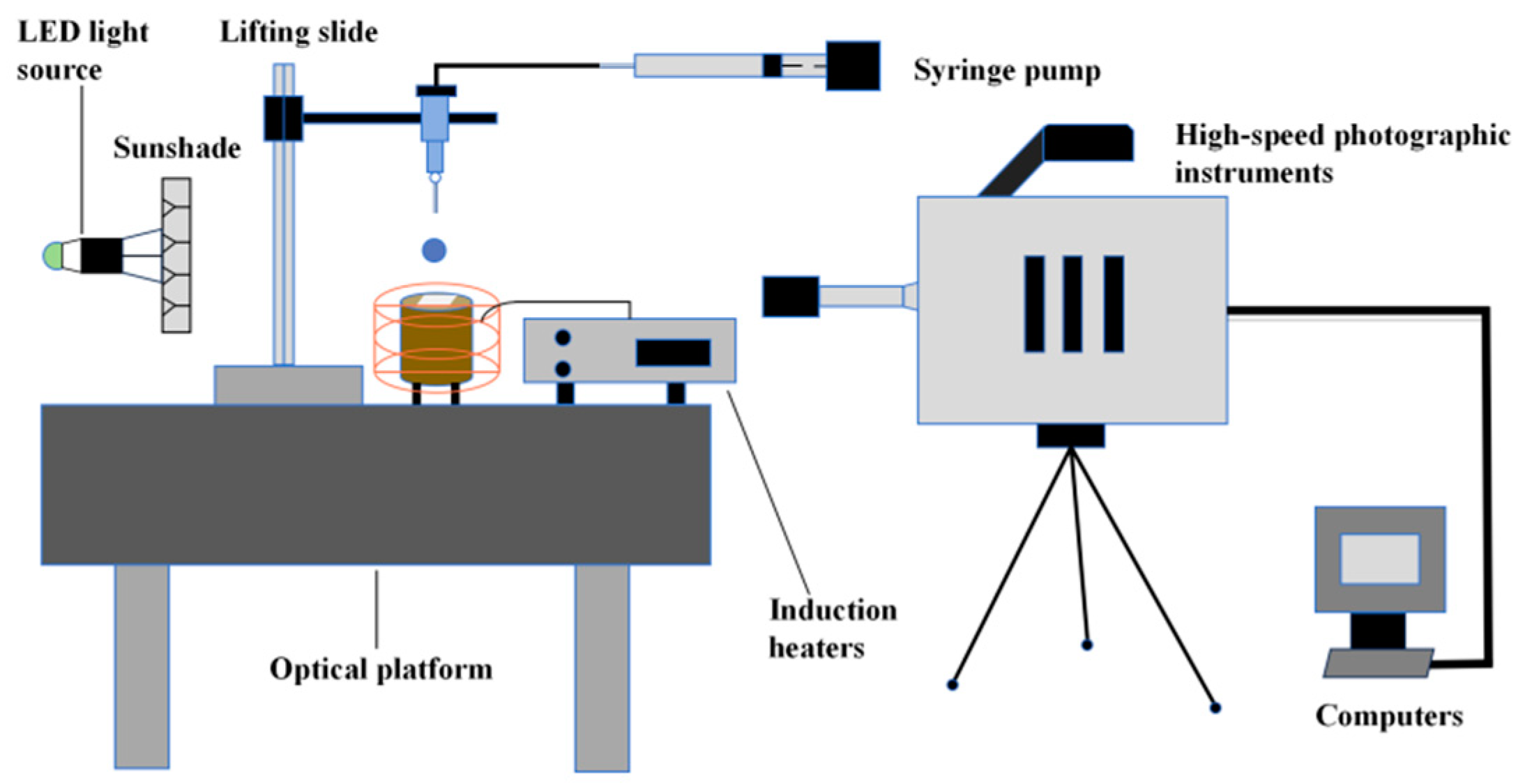
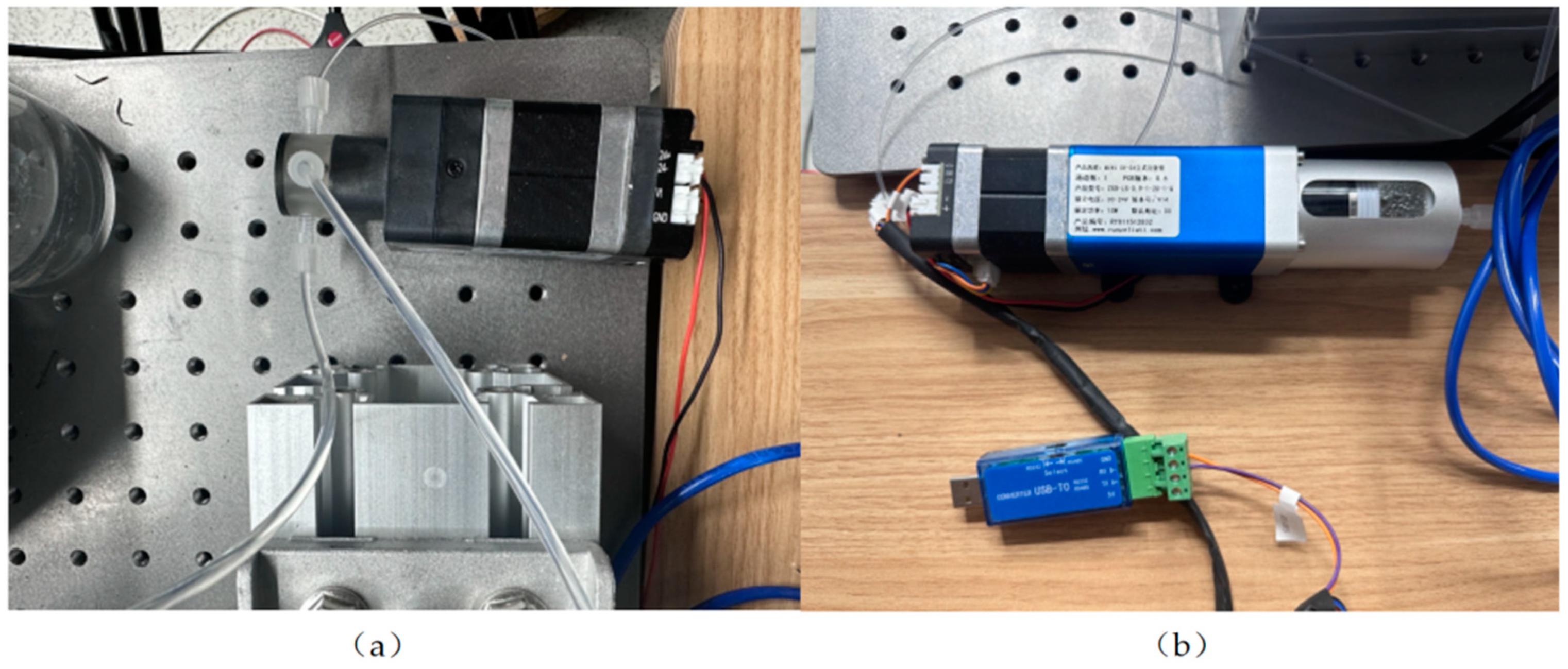

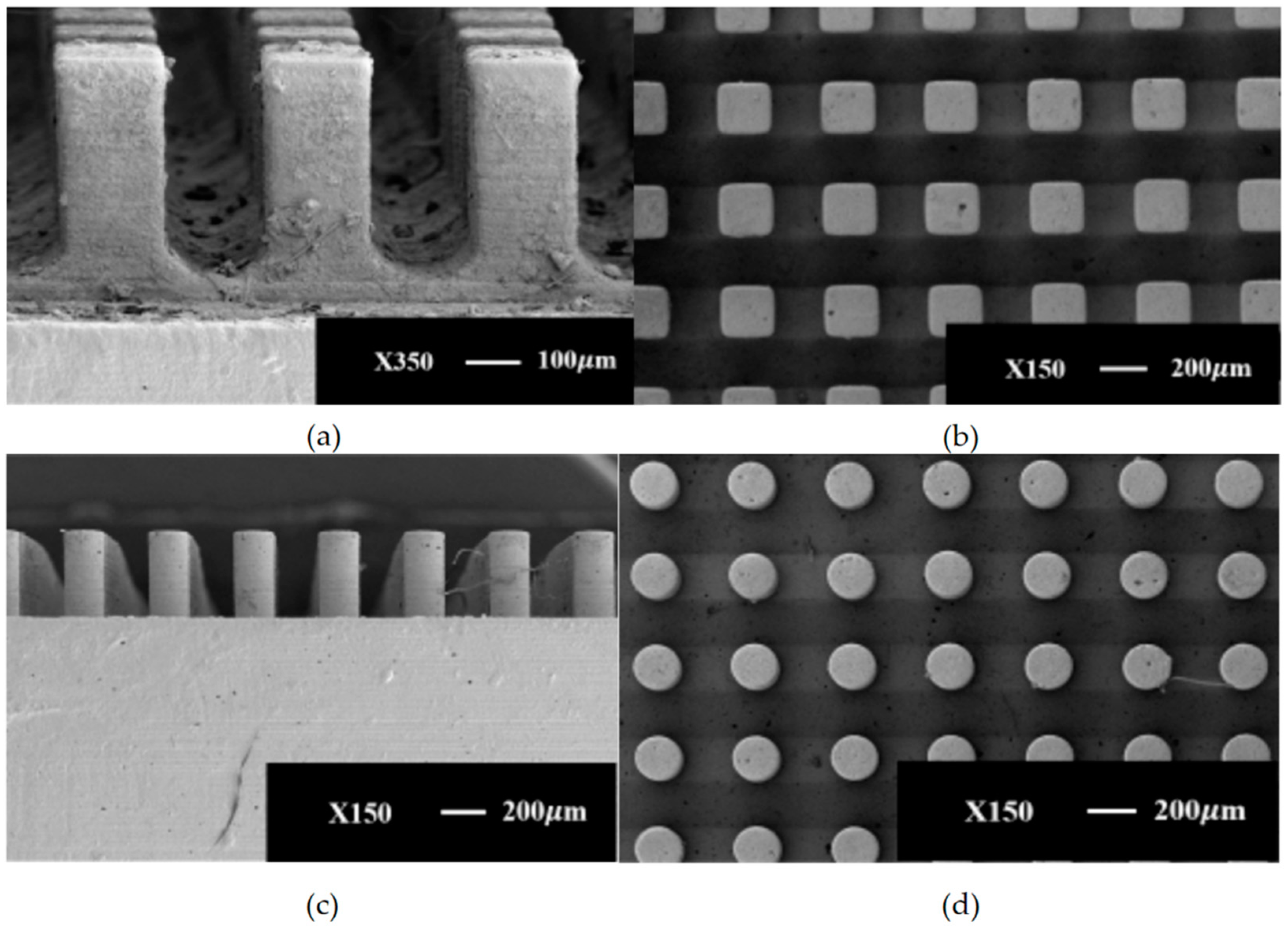
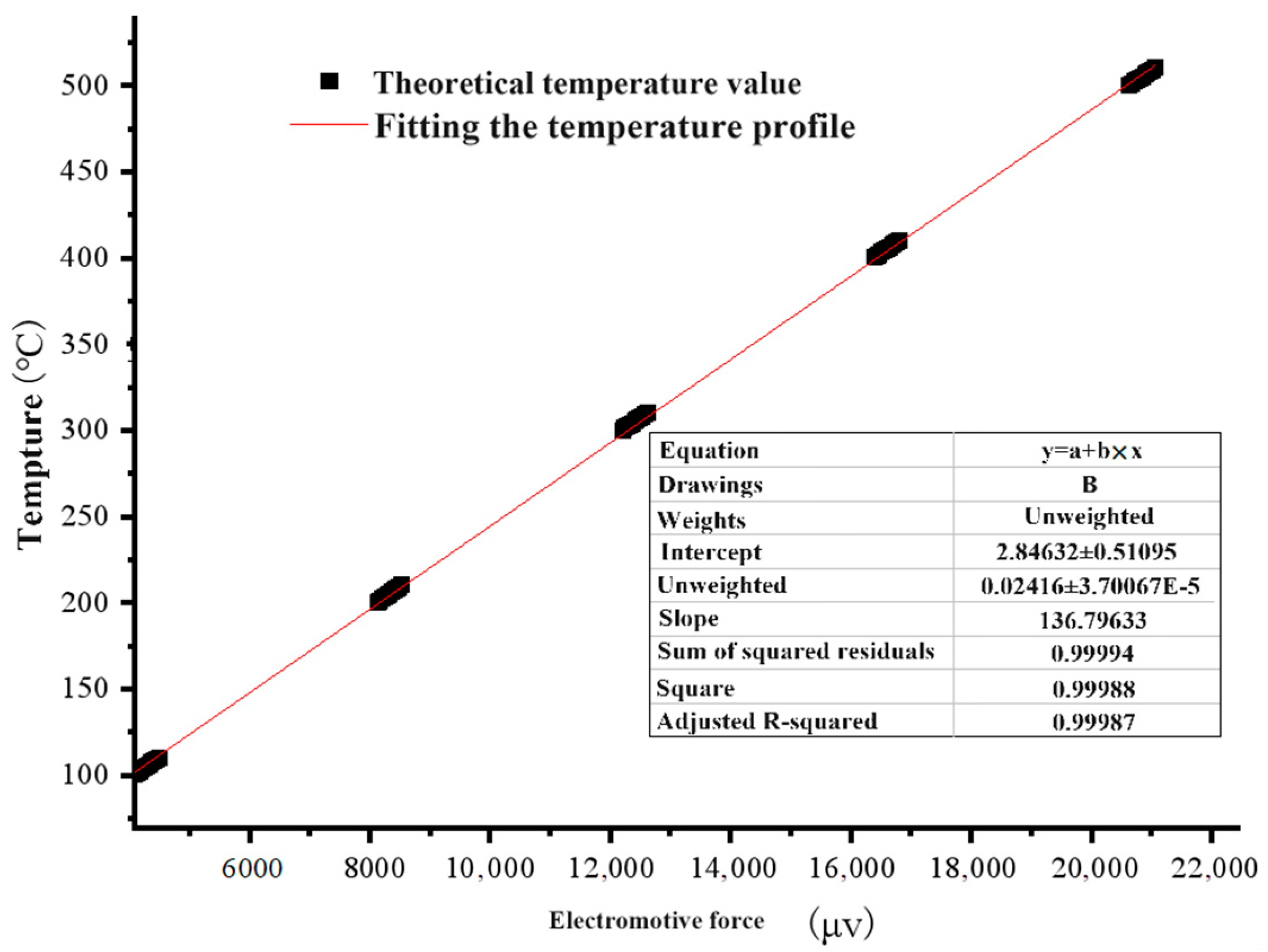
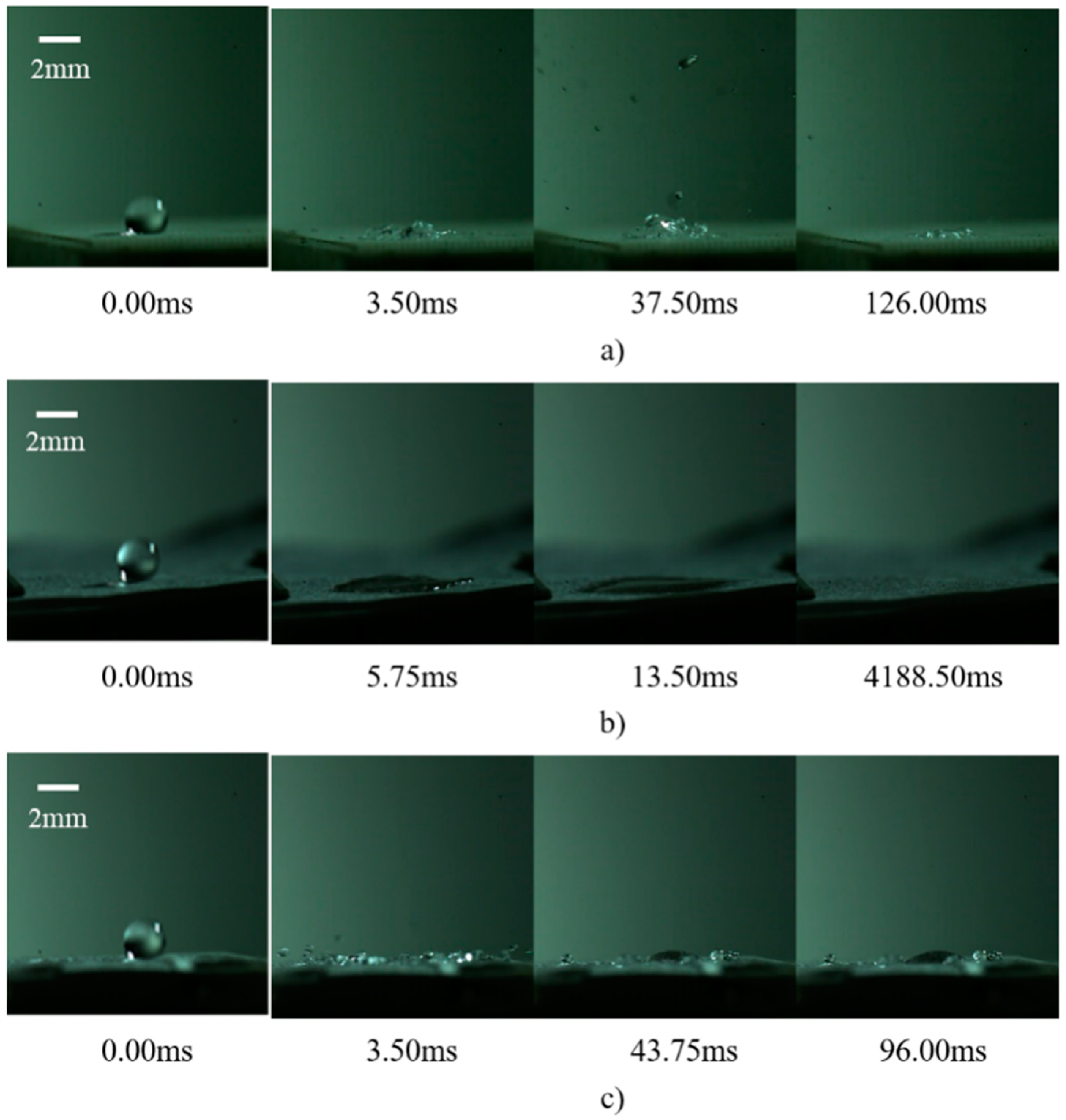




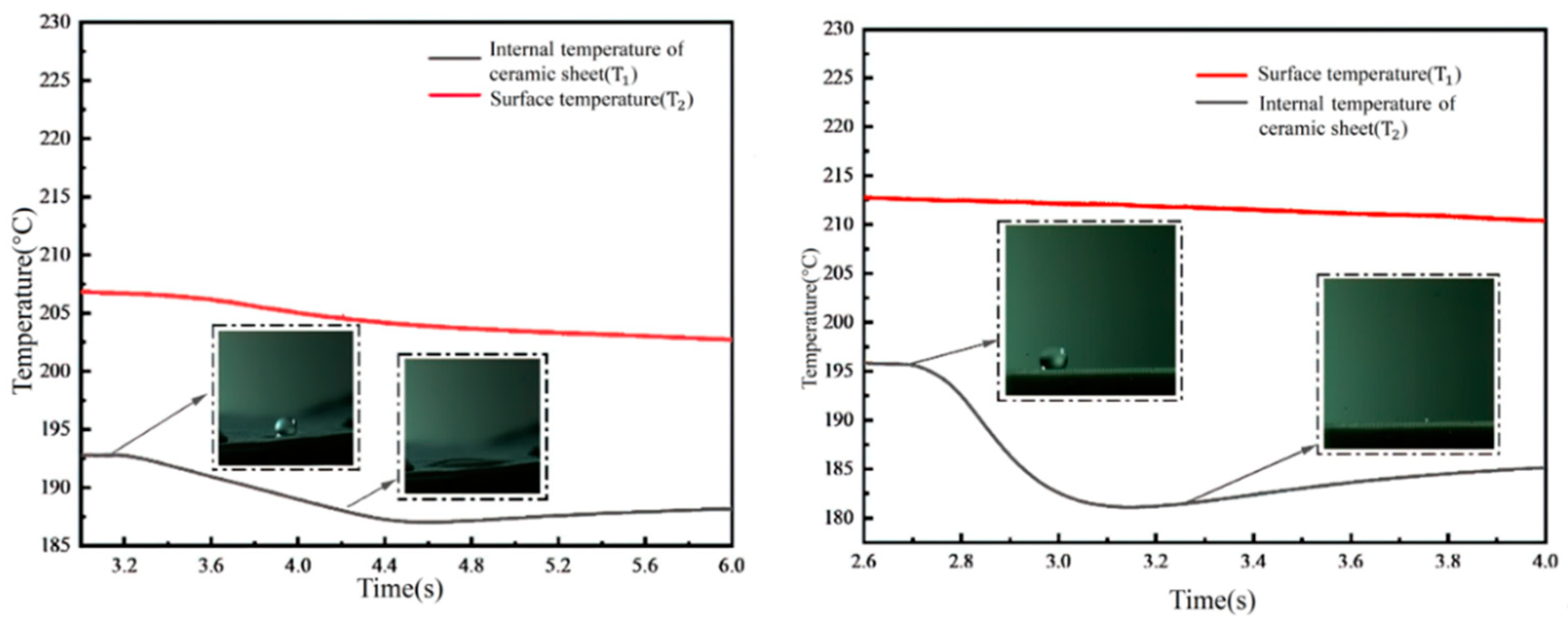
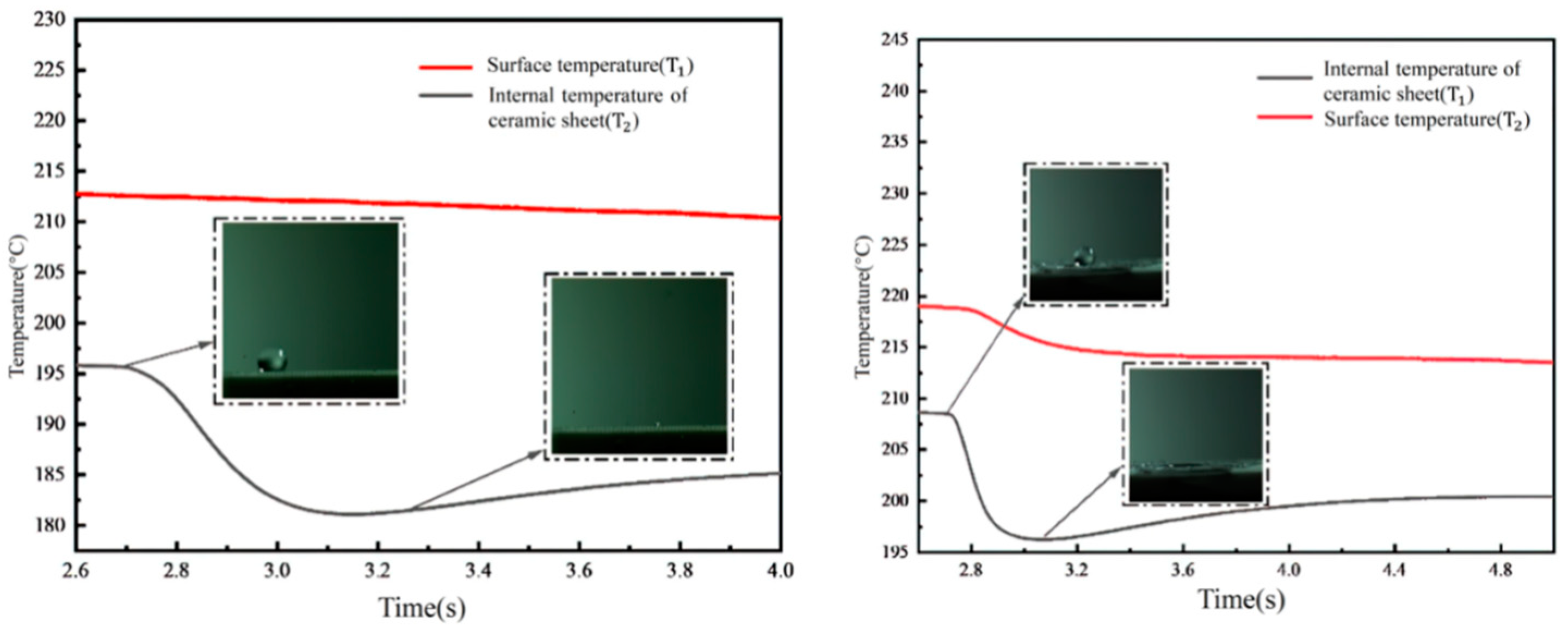
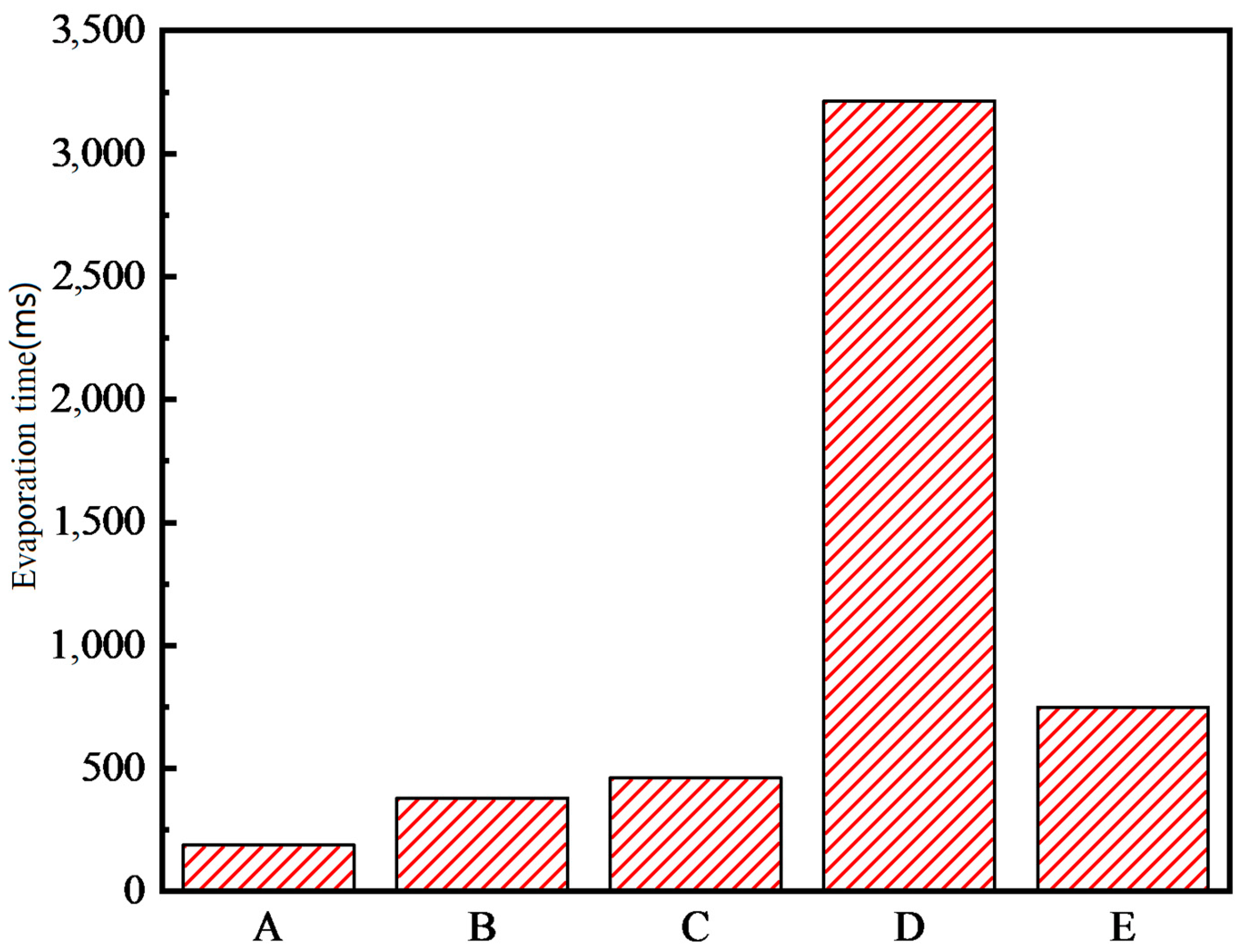
| Sources of Error | Error Value (°C) | Relative Uncertainties (%) |
|---|---|---|
| Thermocouple error | ±0.5 | 0.75% |
| Droplet impact distance | — | 0.39% |
| Droplet impact time | — | 0.11% |
| Droplet velocity | — | 0.20% |
| Droplet size | — | 0.03% |
| Heat flow | — | 2.34% |
| Microcolumn Array Structures | Height (μm) | Diameter (μm) | Spacing (μm) |
|---|---|---|---|
| Rectangular micropillar array | 200 | 200 | 450 |
| Cylindrical micropillar array | 450 | 200 | 400 |
| Micro Columnar Structure | Arrangement | Droplet Diameter (mm) | Impact Velocity (m/s) | Wall Temperature (°C) | |
|---|---|---|---|---|---|
| 1 | Rectangular micropillar array | No fiber membrane | 2 ± 0.2 | 2.23 | 200 ± 10 |
| 2 | Rectangular micropillar array | Fiber membrane on top | 2 ± 0.2 | 2.23 | 200 ± 10 |
| 3 | Rectangular micropillar array | Fiber membrane placed inside | 2 ± 0.2 | 2.23 | 200 ± 10 |
| 4 | Cylindrical micropillar array | No fiber membrane | 2 ± 0.2 | 2.23 | 200 ± 10 |
| 5 | Cylindrical micropillar array | Fiber membrane on top | 2 ± 0.2 | 2.23 | 200 ± 10 |
| 6 | Cylindrical micropillar array | Fiber membrane placed inside | 2 ± 0.2 | 2.23 | 200 ± 10 |
| Sample Name | Materials | Density (Kg/m3) | Specific Heat Capacity K) | Thermal Conductivity K) |
|---|---|---|---|---|
| High-temperature ceramics | Aluminum oxide | 3819.40 | 2.27 | 1.79 |
Disclaimer/Publisher’s Note: The statements, opinions and data contained in all publications are solely those of the individual author(s) and contributor(s) and not of MDPI and/or the editor(s). MDPI and/or the editor(s) disclaim responsibility for any injury to people or property resulting from any ideas, methods, instructions or products referred to in the content. |
© 2024 by the authors. Licensee MDPI, Basel, Switzerland. This article is an open access article distributed under the terms and conditions of the Creative Commons Attribution (CC BY) license (https://creativecommons.org/licenses/by/4.0/).
Share and Cite
Zhang, D.; Zhang, G.; Li, Y.; Jiang, Y.; Yu, Y. Impact of Ceramic Micropillar Array and Fiber Layer Composite Structure on Kinematic and Heat Transfer Characteristics of Single Droplet Impacting a Wall. Micromachines 2024, 15, 525. https://doi.org/10.3390/mi15040525
Zhang D, Zhang G, Li Y, Jiang Y, Yu Y. Impact of Ceramic Micropillar Array and Fiber Layer Composite Structure on Kinematic and Heat Transfer Characteristics of Single Droplet Impacting a Wall. Micromachines. 2024; 15(4):525. https://doi.org/10.3390/mi15040525
Chicago/Turabian StyleZhang, Dechao, Guangjing Zhang, Yiwei Li, Yaobin Jiang, and Yusong Yu. 2024. "Impact of Ceramic Micropillar Array and Fiber Layer Composite Structure on Kinematic and Heat Transfer Characteristics of Single Droplet Impacting a Wall" Micromachines 15, no. 4: 525. https://doi.org/10.3390/mi15040525





